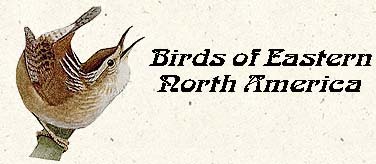
|
|
|
|
Blackpoll Warbler (Dendroica striata) Identification: 4.5 inches from tip of bill to tip of tail.
Similar Species: The breeding male might be confused with Black-and-white Warbler. However the Blackpoll Warbler has a solid black head crown, but that of the Black-and-white Warbler has black and white stripes. The Black-and-white Warbler has a black trapezoid behind the eye that is missing in the Blackpool Warbler. Fall Blackpoll Warblers and immatures are similar to many fall and immature individuals of other warbler species. The following combination of characters will usually identify fall, female, and immature Blackpoll individuals; The back is strongly streaked with dark brown or black, wing bars are present, a black streak runs through the eye, and the feet and legs are usually flesh colored. In contrast the feet of the Pine Warbler and Bay-breasted Warbler are black. The Pine Warbler lacks streaks on the back. Breeding Range (see map below): The Blackpoll Warbler is a species of the north ranging from Labrador in the east to most of Alaska in the west. The species extends southward, barely entering the United States in Maine and New Hampshire. Overwintering Range: American tropics. Habitat: The Blackpoll Warbler is found in the northern coniferous forests right up to the transition to the tundra. During migration the species is found in tall trees. Food: Insects. Behavior: The song is a rapid series of notes of the same pitch, but variable volume, increasing and then decreasing in volume. Reproduction: The nest is constructed of twigs and grass, lined with feathers. The nest is placed in a small conifer. The clutch consists of 4 or 5 white eggs with brown spots. Incubation takes about 12 days, and the youngster leaves the nest about 12 days after hatching. Notes: The Blackpoll Warbler is one of the most abundant warblers during spring migration.
|